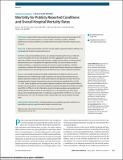| dc.contributor.author | McCrum, Marta L. | |
| dc.contributor.author | Joynt, Karen E. | |
| dc.contributor.author | Orav, E. John | |
| dc.contributor.author | Gawande, Atul | |
| dc.contributor.author | Jha, Ashish K. | |
| dc.date.accessioned | 2019-03-29T10:33:07Z | |
| dc.date.issued | 2013 | |
| dc.identifier.citation | McCrum, Marta L., Karen E. Joynt, E. John Orav, Atul A. Gawande, and Ashish K. Jha. 2013. “Mortality for Publicly Reported Conditions and Overall Hospital Mortality Rates.” JAMA Internal Medicine 173 (14): 1351. https://doi.org/10.1001/jamainternmed.2013.7049. | |
| dc.identifier.issn | 2168-6106 | |
| dc.identifier.issn | 2168-6114 | |
| dc.identifier.uri | http://nrs.harvard.edu/urn-3:HUL.InstRepos:38846209 | * |
| dc.description.abstract | IMPORTANCE Federal efforts about public reporting and quality improvement programs for hospitals have focused primarily on a small number of medical conditions. Whether performance on these conditions accurately predicts the quality of broader hospital care is unknown. OBJECTIVE To determine whether mortality rates for publicly reported medical conditions are correlated with hospitals' overall performance. METHODS Using national Medicare data, we compared hospital performance at 2322 US acute care hospitals on 30-day risk-adjusted mortality, aggregated across the 3 publicly reported conditions (acute myocardial infarction, congestive heart failure, and pneumonia), with performance on a composite risk-adjusted mortality rate across 9 other common medical conditions, a composite mortality rate across 10 surgical conditions, and both composites combined. We also examined the relationship between alternative surrogates of quality (hospital size and teaching status) and performance on these composite outcomes. RESULTS Our sample included 6 670 859 hospitalizations for Medicare fee-for-service beneficiaries from 2008 through 2009. Hospitals in the top quartile of performance on publicly reported conditions had a 3.6% lower absolute risk-adjusted mortality rate on the combined medical-surgical composite than those in the bottom quartile (9.4% vs 13.0%; P < .001). These top performers on publicly reported conditions had 5 times greater odds of being in the top quartile on the overall combined composite risk-adjusted mortality rate (odds ratio [OR], 5.3; 95% CI, 4.3-6.5). Mortality rates for the index condition were predictive of medical (OR, 8.4; 95% CI, 6.8-10.3) and surgical (2.7; 2.2-3.3) performance when these groups were considered separately. In comparison, large size (OR, 1.9; 95% CI, 1.5-2.4) and teaching status (2.4; 1.8-3.2) showed weaker relationships with overall hospital mortality rates. CONCLUSIONS AND RELEVANCE Hospital performance on publicly reported conditions can potentially be used as a signal of overall hospital mortality rates. | |
| dc.language.iso | en_US | |
| dash.license | LAA | |
| dc.title | Mortality for Publicly Reported Conditions and Overall Hospital Mortality Rates | |
| dc.type | Journal Article | |
| dc.description.version | Version of Record | |
| dc.relation.journal | JAMA Internal Medicine | |
| dash.depositing.author | Gawande, Atul | |
| dc.date.available | 2019-03-29T10:33:07Z | |
| dash.workflow.comments | 1Science Serial ID 44469 | |
| dc.identifier.doi | 10.1001/jamainternmed.2013.7049 | |
| dash.source.volume | 173;14 | |
| dash.source.page | 1351 | |
| dash.contributor.affiliated | Gawande, Atul | |


